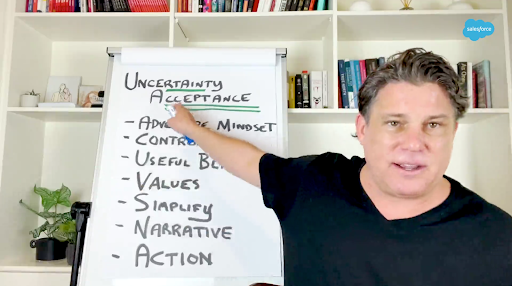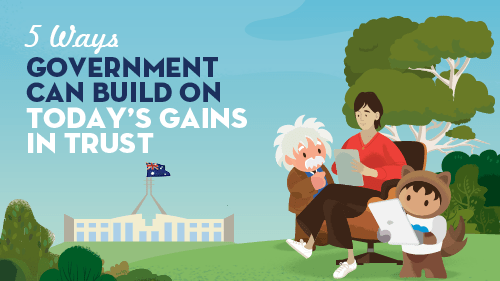Leapfrogging Forward Requires Putting People First – Here’s How



Need to move fast on transformation? You’re not alone. Here’s why people need to be front and centre – and how to drive successful change.
Salesforce Staff
There’s been plenty of talk around why transformation is so important and why so many organisations need to slingshot past incremental stages of digitisation. Those are important conversations, especially with the public sector facing growing urgency to digitise. But it’s also critical to talk about the ‘how’. Jackie Cook, who specialises in helping organisations make transformation goals a reality, explains why part of the answer is keeping things human.
Transformation projects used to span years and huge chunks of budget. But, now, that’s already starting to look like ancient history.
Pandemic responses famously disproved the notion that transformation can’t happen quickly, while decision-makers expect to see quick wins before agreeing to larger budgets. This is true across all industries and sectors, but it’s reached new levels of urgency in the public sector. Not only are more Australians going online for government services, but data sharing and digital solutions are increasingly necessary to deliver on agencies’ missions.
The result has been a stampede toward digital transformation. Slow, steady transformation might have been enough five years ago, but the mass shift toward digitisation leaves most organisations – both public and private – needing to leapfrog incremental change and into totally new models, mindsets and ways of working.
You’ve probably heard a lot of this before. But transformation was already easier said than done. How can you drive change now that the goals are bigger and the stakes are higher?
Technology is certainly part of the answer, but people are at the heart of it. You’ve probably heard that, too. What we don’t hear about enough are the practical steps you can take to put people at the centre of successful solutions.
Match tech requirements with an empathetic understanding of your people and capabilities
When we’re talking about new systems and new capabilities, which is often what we’re talking about when we discuss transformation, we sometimes assume everybody has a perfect, homogeneous set of skills that will allow you to get the most out of any new system. But that might not factor in the actual skillsets or day-to-day realities of the people who make up an organisation.
For instance, someone might be a subject matter expert in marketing, but that doesn’t mean they’ll know enough about your new digital marketing system to get the most out of it. And your transformation might be in trouble if you just assume they’ll have all the time and resources necessary to work it out on their own.
What’s the solution? Part of it could be embedding solution gurus across value chain areas, ensuring there’s always a person who can champion new ways of working and support others in the journey. In a smaller business or agency, it could be most or all of the staff who are trained.
Whatever happens, the ambition for the technology needs to be matched by the technical capability of the workforce. An empathetic understanding of that capability should inform your planning before and after you implement new technologies.
Involve end users early, incorporating human-centred design principles as you go
There are many ways you can do this, but sending out a single survey and calling it a day isn’t one of them. Instead, incorporate human-centred design principles by putting your end users at the centre of everything you’re doing. Make them an integral part of every phase – and aim for as early in the process as possible.
Practically, that means investigating hurdles they face or why they use certain tools in certain ways. You won’t find answers you need through closed questions, so seek out open-ended discussions and dig deeper.
If you’re starting with these sorts of user perspectives and problems, rather than bringing them in after you’ve already started planning, you’ll have a greater chance of ensuring that what comes out the other end is of genuine value. After all, if end users don’t value it, they won’t use it.
Create rapid testing and feedback loops
Listening to users doesn’t end with planning or design. And while you might find terms like ‘rapid testing’ in conversations between developers, that doesn’t mean it’s just tech speak. Testing and feedback loops are all about keeping your finger on the pulse – they’re how you anchor solutions in the actual problems of actual people.
Of course, you can’t act on every piece of feedback, nor should you. But, in order to consider whether it’s worth acting on, you have to gather it and record it. To do this, you need a consistent way to measure the value of each suggestion. This comes back to whether it will make a difference to your pre-agreed KPIs (more on those later).
Build out distinct roles that support your ambition
Especially if you’re trying to leapfrog several stages of transformation, how will your people drive innovation and keep the lights on at the same? After all, those are very different endeavours, demanding different skill sets.
This is the part that can feel like trying to change the wheels of the bus while it’s in motion. But, if you’re clear-eyed about how your ambition matches with your internal capabilities, you can make sure the right people are in the right places. For instance, you might designate a team of innovators whose focus is evolving your solution and making that leapfrog happen. This can fit hand-in-glove with providing embedded champions or additional training within the teams responsible for keeping the organisation ticking along.
All of this requires great knowledge of your organisation and its goals. But that’s not sufficient without an even greater understanding of the people responsible for making those goals happen.
Rally leaders around shared KPIs and deeper culture shifts
Lastly, but maybe most importantly, is bringing people together around a shared vision and definition of success.
Whenever I’ve dissected a failed transformation, we tend to find misaligned KPIs. So many times when things fail, it’s because the scope isn’t clear. It’s because people want different things. It’s because the teams get pulled in multiple directions, and the confusion might get misidentified as ‘agile’.
Of course, there’s a lot of work around technical requirements, security issues and other ‘hard’ factors. But success relies on making sure leaders fully understand and agree on what the project should deliver, which is a fundamentally human exercise in diplomacy and communication.
This alignment also matters because leaders are often the ones who determine the ‘soft’ factors like culture and mindset, which can make or break a project no matter how much work you do around the ‘hard’ factors.
Many organisations have never faced more urgent imperatives to transform than they do now. When the stakes are high and the timelines are short, it’s crucial to stay focused on the practical steps forward. And, at every step, your people will be key for making sure you’re headed in the right direction.
Understanding success in your sector
These principles are relevant no matter your sector or industry, but the COVID-19 pandemic has underscored the importance of digital government. Find out how Salesforce solutions can help public sector organisations transform.
Want more?


















